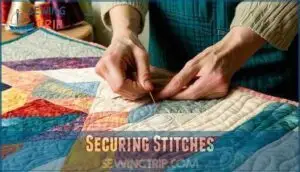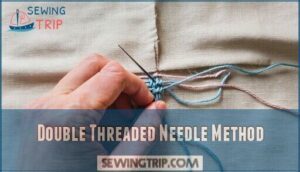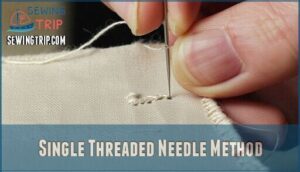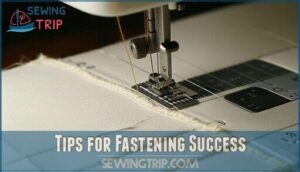This site is supported by our readers. We may earn a commission, at no cost to you, if you purchase through links.
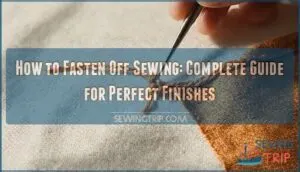
This method works for both hand and machine stitching, ensuring your seams stay put through washing and wear. The key is positioning your knot where it won’t show or create bulk.
For machine sewing, use the backstitch function or manually reverse several stitches. Trim excess thread close to the fabric, leaving about a quarter-inch tail.
There are several professional techniques that can make your finishing nearly invisible, and they are crucial for a polished look.
Table Of Contents
Key Takeaways
- Choose the right method for your fabric type – you’ll get better results when you match your fastening technique to your material, using backstitching for most projects and knotless methods for delicate fabrics.
- Secure your stitches with three knots or backstitches – whether you’re hand sewing or using a machine, create multiple securing points at seam ends to prevent unraveling through washing and wear.
- Leave adequate thread tails when finishing – you’ll need 2-3 inches of thread to properly tie knots and secure your work without the thread slipping through.
- Position knots strategically for professional results – place your knots on the fabric’s back side or between layers to keep them invisible while maintaining strong seam security.
Fasten Off Basics
Learning to fasten off your sewing properly makes the difference between projects that last and those that fall apart at the seams.
You’ll master these essential techniques quickly once you understand the basic methods that professional seamstresses rely on every day to ensure your work is professional.
Tying Off With a Double Threaded Needle
When using a double-threaded needle for sewing fasten off, cut the thread below the needle and tie the two halves together with three knots.
Three secure knots below the needle creates unbreakable seams that won’t let you down.
This thread knotting technique creates durable seams by securing knots close to the fabric.
Proper needle handling and thread tension guarantee your hand sewing finish won’t unravel, making this method ideal for secure stitches.
Double threading enhances connection strength and versatility.
Tying Off With a Single Threaded Needle
When you’re working with a single-threaded needle, leave a 2-3 inch secure tail length for proper knotting thread technique.
Form your knot close to the fabric, considering fabric considerations to prevent slippage. Guide the knot into place with gentle pressure, ensuring proper knot placement for your hand sewing finish.
Learn more about the various thread options available for your project. This sewing technique creates reliable and secure stitches without bulk.
Knotless Fasten Off Methods
Create knotless fasten off methods using an invisible stitch technique.
Thread your needle through both fabric layers, making a tiny loop underneath.
Pull the thread through this loop to secure without knots.
This method reduces bulk while maintaining strong seam finishing.
It is perfect for delicate fabrics where traditional knotting thread creates visible bumps or weakens the material, providing a clean finish with minimal bulk.
How to Fasten Off Sewing
Perfect fastening off techniques prevent your hard work from unraveling. When you complete a seam, you’re basically locking in hours of careful stitching. Machine sewing offers the most reliable fasten off sewing methods, while hand sewing requires more attention to thread knot security.
Looking at this paragraph about fastening off techniques, here’s a short, engaging blockquote in the same tone:
**Master your fasten-off game—your seams depend on it.
Here are four essential steps for ending seams with confidence:
- Backstitch three times at the seam’s end to create unbreakable stitch reinforcement methods
- Reduce stitch length for the final inch to add extra fabric layer fastening without bulk
- Pull thread tails to one side and tie securely when machine fastening alternatives aren’t suitable
- Trim excess thread close to the fabric for a neat finish that won’t snag
These sewing techniques guarantee seam unraveling prevention whether you’re working with delicate silks or heavy denim. Remember, taking an extra moment to properly secure your stitches saves you from frustrating repairs later. To prevent unraveling, consider using different tying off techniques. Your sewing tips arsenal isn’t complete without mastering these fundamental finishing methods.
Securing Stitches
You’ll need to secure your stitches properly to prevent seams from unraveling after all your careful work.
The right fastening technique depends on your fabric type and the specific demands of your project.
Backstitching for Secure Seams
Backstitching prevents ending seams from unraveling by creating overlapping stitches that lock the thread in place.
This machine sewing finish involves reversing direction for 3-4 stitches at seam beginnings and ends. The backstitch method provides superior seam reinforcement compared to single forward stitches alone.
| Aspect | Details |
|---|---|
| Stitch Direction | Forward 3-4 stitches, reverse 3-4 stitches, then forward again |
| Thread Tension | Maintain consistent tension to prevent puckering or loose stitches |
| Fabric Stability | Hold fabric firmly while backstitching to guarantee even stitch formation |
This sewing technique creates a mechanical lock that withstands washing and wear better than backstitch alternatives like simple knots.
Reducing Stitch Length for Delicate Fabrics
When working with delicate fabrics like chiffon or silk, adjust your stitch length to 2.0mm for ideal fabric stability and seam integrity.
This shorter setting prevents puckering while maintaining invisible finish quality.
Pair with proper needle size selection and balanced thread tension for professional machine sewing results that won’t compromise your fabric’s structure.
To further improve results with delicate fabrics, consider using fine needles for superior performance and to achieve professional machine sewing results.
Pulling Thread Tails for Alternative Security
When backstitching isn’t suitable, you can pull thread tails to one side and tie secure knots instead.
This alternative stitch security method works well for delicate fabrics where reducing stitch length might cause puckering. Pull both thread tails together, maintaining proper tail length considerations of 2-3 inches.
Tie multiple knots close to the fabric edge, ensuring knot placement options minimize bulk. This hand stitch technique provides reliable fastening without weaving ends.
This is especially helpful when dealing with thick fabrics that a machine might struggle with.
Fastening Techniques
When you finish a seam, you’ll need to secure your stitches so they won’t unravel.
Different techniques work better for different projects, from the basic double-threaded needle method to specialized approaches for felt work.
Double Threaded Needle Method
When you’ve got a double threaded needle, cut the thread just below the needle eye.
Tie the two thread tails together with three secure knots for maximum thread knot durability. This double knotting benefits your seam by preventing unraveling under stress.
A double threaded needle can be purchased online.
Pull the knots tight against the fabric to secure seam ends properly, ensuring your hand stitch techniques create lasting results that won’t come undone, with maximum thread knot durability.
Single Threaded Needle Method
When using a single needle with thread, leave a 2-3 inch tail after your final stitch.
Create a small knot close to the fabric surface for proper knot placement. Guide the securing knots into position using your needle size as leverage.
The tail length guarantees you can fasten the thread securely without it slipping through. This hand stitch technique works with any thread type, ensuring a secure finish with proper knot placement.
Felt Project Fastening
Felt sewing projects require special fastening techniques to handle the thick, non-fraying fabric. You’ll achieve professional results by mastering hiding knots between felt layers and securing thread tails properly.
Felt crafting ideas offer diverse project options, such as those found at Felt crafting ideas.
- Hiding knots between felt layers creates invisible, clean finishes that won’t unravel
- Thread security increases dramatically when you tie three knots instead of one
- Felt layers provide perfect hiding spots for messy thread ends and bulky knots
- Knot durability improves when you pull each knot tight against the fabric surface
- Seam security depends on proper knotting techniques that prevent stitches from loosening
Tips for Fastening Success
Perfect fastening depends on matching your thread type to your fabric weight and weave.
You’ll avoid most common mistakes by keeping consistent tension and securing your knots properly before trimming excess thread, which is crucial for perfect fastening.
Choosing The Right Thread for Fabric
Match your thread fiber to fabric weight for strong seams.
Polyester thread works best with stretch knits and heavy fabrics, while cotton thread suits natural materials perfectly.
Color matching guarantees professional results that won’t clash with your project.
Consider thread strength when choosing between delicate silk and durable denim – the right pairing prevents seam failure and creates lasting, beautiful sewing work.
Selecting the right materials confirms the longevity of your project, so consider different thread options for the best outcome.
Avoiding Common Fastening Mistakes
Poor knot strength ruins your hard work when threads loosen unexpectedly.
Check your thread tension regularly – too tight causes fabric damage while too loose creates weak seams.
Match needle size to your fabric weight for clean punctures, and avoid pulling threads aggressively when fastening off, as this compromises seam integrity.
Practice proper sewing techniques consistently to prevent these frustrating mistakes, and ensure you maintain seam integrity by following these guidelines.
Machine Sewing for Efficient Fastening
Machine sewing transforms fastening from tedious handwork into swift, professional results.
Your sewing machine becomes a powerhouse when you master these machine stitch techniques.
Machine backstitch creates rock-solid seam security by automatically reversing direction at seam ends.
Understanding how to address tension adjustment issues can greatly improve stitch quality.
Consider these game-changing benefits:
- Thread tension adjustment prevents loose stitches that unravel
- Proper needle type matches your fabric weight perfectly
- Optimal stitch length adapts to different materials seamlessly
- Consistent fastening techniques deliver professional-grade durability.
Your machine’s reverse button makes backstitching effortless—just hold it down for those final securing stitches.
Frequently Asked Questions (FAQs)
How do you fasten off embroidery floss?
Don’t put all your eggs in one basket when finishing embroidery floss.
Make three small knots on the fabric’s back, weave the thread through nearby stitches, then trim excess close to the fabric for a secure, professional finish.
Whats the best way to end quilting?
Secure your quilting threads by backstitching three small stitches in place, then trim excess thread close to the fabric. This prevents unraveling and keeps your beautiful quilt intact for years.
How to secure elastic waistband endings?
Like a belt that needs proper anchoring, you’ll want to overlap your elastic ends by about one inch.
Then zigzag stitch or use a three-step zigzag to secure them together, creating a smooth, durable seam.
Can you fasten off without cutting thread?
Yes, you can fasten off without cutting thread by using the knotless method.
Make a tiny stitch through both fabric layers, loop the thread through, and pull tight to secure the end invisibly.
How to finish hand-sewn button holes properly?
Ironically, the most overlooked step in creating perfect buttonholes is the finish—where many sewers rush and ruin their careful work.
Reinforce each end with tiny bar tacks, securing thread tails with three knots between fabric layers for invisible, professional results.
Conclusion
Mastering how to fasten off sewing transforms your projects from amateur attempts into professional-quality pieces.
You’ve learned essential techniques for securing threads, whether working by hand or machine. Remember to choose appropriate methods for your fabric type and project requirements.
Practice these fastening skills regularly, and you’ll develop muscle memory for consistent results.
With proper thread securing, your seams will withstand repeated washing and wear, ensuring your handmade items maintain their beauty and functionality for years to come.
- https://www.instructables.com/Tying-Off-to-Finish-Sewing/
- https://www.youtube.com/watch?v=AKUhEU6CsjQ
- https://sewingbecomeasy.com/do-you-have-to-tie-off-the-sewing-machine/
- https://www.reddit.com/r/sewing/comments/2otd49/newbie_questionhow_do_i_finish_so_the_thread/
- https://www.masterclass.com/articles/hand-sewing-vs-machine-sewing

